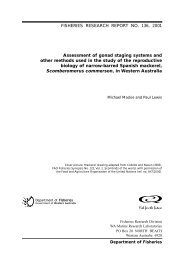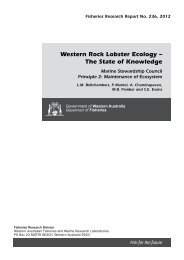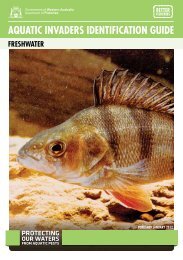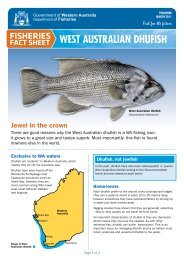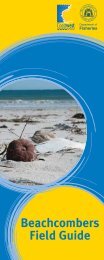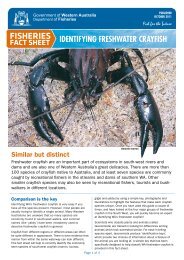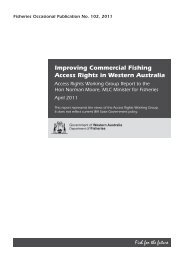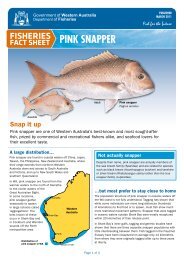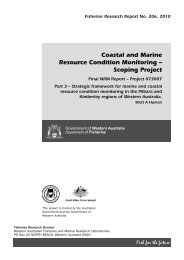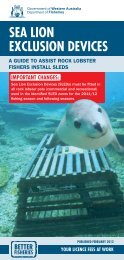DEPARTMENT OF FISHERIES ANNUAL REPORT TO THE ...
DEPARTMENT OF FISHERIES ANNUAL REPORT TO THE ...
DEPARTMENT OF FISHERIES ANNUAL REPORT TO THE ...
Create successful ePaper yourself
Turn your PDF publications into a flip-book with our unique Google optimized e-Paper software.
DISCLOSURES AND LEgAL COMPLIANCE � NOTES <strong>TO</strong> <strong>THE</strong> FINANCIAL STATEMENTS<br />
Licences up to 10 years<br />
Development Costs 3 to 5 years<br />
Software(a) 3 to 5 years<br />
Web site costs 3 to 5 years<br />
(a) Software that is not integral to the operation of any related hardware.<br />
Licences<br />
Licences have a finite useful life and are carried at cost less accumulated amortisation<br />
and accumulated impairment losses.<br />
Research and Development<br />
Research costs are expensed as incurred. Development costs incurred for an individual<br />
project are carried forward when the future recoverability can reasonably be regarded as<br />
assured and the total project costs are likely to exceed $50,000. Other development<br />
costs are expensed as incurred.<br />
Computer Software<br />
Software that is an integral part of the related hardware is treated as property, plant and<br />
equipment. Software that is not an integral part of the related hardware is treated as an<br />
intangible asset. Software costing less than $5,000 is expensed in the year of acquisition.<br />
Website costs<br />
Website costs are charged as expenses when they are incurred unless they relate to the<br />
acquisition or development of an asset when they may be capitalised and amortised.<br />
Generally, costs in relation to feasibility studies during the planning phase of a web site,<br />
and ongoing costs of maintenance during the operating phase are expensed. Costs<br />
incurred in building or enhancing a website, to the extent that they represent probable<br />
future economic benefits that can be reliably measured, are capitalised.<br />
(i) Impairment of Assets<br />
Property, plant, equipment and infrastructure are tested for any indication of impairment<br />
at the end of each reporting period. Where there is an indication of impairment, the<br />
recoverable amount is estimated. Where the recoverable amount is less than the carrying<br />
amount, the asset is considered impaired and is written down to the recoverable amount<br />
and an impairment loss is recognised. As the Department is a not-for-profit entity, unless<br />
an asset has been identified as a surplus asset, the recoverable amount is the higher of<br />
an asset’s fair value less costs to sell and depreciated replacement cost.<br />
The risk of impairment is generally limited to circumstances where an asset’s depreciation<br />
is materially understated, where the replacement cost is falling or where there is a<br />
significant change in useful life. Each relevant class of assets is reviewed annually to<br />
verify that the accumulated depreciation/amortisation reflects the level of consumption or<br />
expiration of asset’s future economic benefits and to evaluate any impairment risk from<br />
falling replacement costs.<br />
The recoverable amount of assets identified as surplus assets is the higher of fair value<br />
less costs to sell and the present value of future cash flows expected to be derived<br />
from the asset. Surplus assets carried at fair value have no risk of material impairment<br />
where fair value is determined by reference to market-based evidence. Where fair value<br />
is determined by reference to depreciated replacement cost, surplus assets are at risk of<br />
impairment and the recoverable amount is measured. Surplus assets at cost are tested<br />
for indications of impairment at the end of each reporting period.<br />
(j) Non-current assets (or disposal groups) classified as held for sale<br />
The department does not have any assets classified as held for sale.<br />
118<br />
(k) leases<br />
Finance lease rights and obligations are initially recognised at the commencement of the<br />
lease term as assets and liabilities equal in amount to the fair value of the leased item or,<br />
if lower, the present value of the minimum lease payments, determined at the inception if<br />
the lease. The assets are disclosed as plant, equipment and vehicles under lease, and are<br />
depreciated over the period during which the Department is expected to benefit from their<br />
use. Minimum lease payments are apportioned between the finance charge and the reduction<br />
of the outstanding lease liability, according to the interest rate implicit in the lease.<br />
The Department holds operating leases for its head office and a number of branch office<br />
buildings. Lease payments are expensed on a straight line basis over the lease term as<br />
this represents the pattern of benefits derived from the leased properties.<br />
(l) financial Instruments<br />
In addition to cash, the Department has two categories of financial instrument:<br />
• Loans and receivables; and<br />
• Financial liabilities measured at amortised cost.<br />
These have been disaggregated into the following classes:<br />
Financial Assets<br />
• Cash and cash equivalents<br />
• Restricted cash and cash equivalents<br />
• Receivables<br />
• Amounts receivable for services<br />
Financial Liabilities<br />
• Payables<br />
• WATC borrowings<br />
• Finance lease liabilities<br />
Initial recognition and measurement of financial instruments is at fair value that normally<br />
equates to the transaction cost or the face value. Subsequent measurement is at<br />
amortised cost using the effective interest method.<br />
The fair value of short-term receivables and payables is the transaction cost or the face<br />
value because there is no interest rate applicable and subsequent measurement is not<br />
required as the effect of discounting is not material.<br />
(m) cash and cash equivalents<br />
For the purpose of the Statement of Cash Flows, cash and cash equivalent (and restricted<br />
cash and cash equivalent) assets comprise cash on hand and short-term deposits with<br />
original maturities of three months or less that are readily convertible to a known amount<br />
of cash and which are subject to insignificant risk of changes in value.<br />
(n) Accrued Salaries<br />
Accrued salaries (refer note 29 ‘Other liabilities’) represent the amount due to staff but<br />
unpaid at the end of the financial year, as the pay date for the last pay period for that<br />
financial year does not coincide with the end of the financial year. Accrued salaries are<br />
settled within a fortnight of the financial year end. The Department considers the carrying<br />
amount of accrued salaries to be equivalent to its net fair value.



